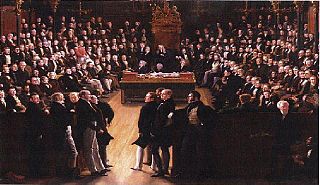Ley de reforma de 1832
De Wikipedia, la enciclopedia libre
La Ley de Reforma de 1832 (en inglés: Representation of the People Act 1832, Reform Act 1832 o Great Reform Act) fue una ley del parlamento que introdujo un amplio espectro de cambios al sistema electoral en Inglaterra y Gales. Según el preámbulo, La ley fue diseñada para "tomar medidas efectivas para corregir diversos abusos que han subsistido durante mucho tiempo en cuanto a la Elección de los Miembros que sirven en la Cámara de los Comunes del Parlamento".

Historia
Resumir
Contexto
Las demandas de reformas se remontaban a mucho antes de 1832, pero siempre sin éxito. La ley que finalmente logró imponerse fue propuesta por los Whigs, liderados por el Primer Ministro Lord Grey. La iniciativa encontró bastante resistencia por parte de fracciones pro Pitt en el Parlamento que habían gobernado el país durante tanto tiempo (la oposición fue especialmente virulenta en la Cámara de los Lores). Sin embargo, a causa de la presión del público, el proyecto fue finalmente aprobado. La ley le otorgaba bancas en la Cámara de los Comunes a las ciudades grandes que habían surgido durante la Revolución Industrial, y le quitaba bancas a los denominados "rotten boroughs" ("burgos podridos", ciudades despobladas que continuaban teniendo su representación de origen medieval). La ley también aumentó el número de individuos habilitados para votar, aumentando la masa del electorado desde unos 500 000 a 813 000, y permitiendo así que uno de cada seis hombres adultos votaran, en una población total de 14 millones de personas.
El título completo es Una ley para modificar la representación del pueblo en Inglaterra y Gales. La ley solo se aplicaba a Inglaterra y Gales; otras leyes de reformas fueron aprobadas ese mismo año para Escocia e Irlanda.[1] Debido a que otras modificaciones fueron aprobadas posteriormente durante el siglo XIX; la ley de reforma de 1832 a veces es denominada la Primera, o la Gran ley de reforma.
Véase también
Notas
Bibliografía
Enlaces externos
Wikiwand - on
Seamless Wikipedia browsing. On steroids.
